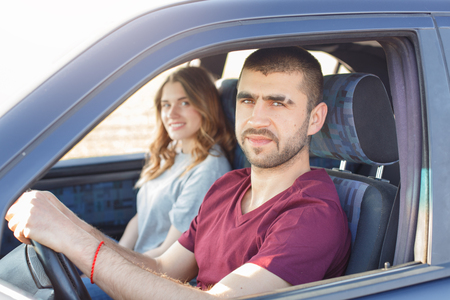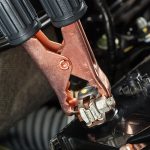1. Staying Calm in High-Stress Moments
Driving emergencies can happen to anyone, especially new drivers. Whether it’s a sudden flat tire, unexpected bad weather, or another vehicle acting unpredictably, keeping your cool is the first step to handling any situation safely. Here are some practical strategies to help you manage anxiety and stay focused when the unexpected happens on the road.
Recognize Your Stress Signals
Everyone reacts differently under pressure. Some people’s hands start shaking, while others might find their heart racing or their thoughts getting jumbled. Noticing these signs early can help you take action before stress takes over.
Common Signs of Driving Anxiety
| Physical Signs | Mental Signs |
|---|---|
| Sweaty palms | Racing thoughts |
| Fast heartbeat | Panic or worry |
| Tense muscles | Trouble focusing |
Simple Techniques to Regain Control
- Breathe Deeply: Take slow, deep breaths in through your nose and out through your mouth. This calms your body and helps clear your mind.
- Focus on What You Can Control: Pay attention to your steering wheel, brakes, and surroundings. Avoid thinking about worst-case scenarios.
- Talk Yourself Through It: Use positive self-talk like “I can handle this” or “Stay calm and focus.” It may sound simple, but it really works.
What To Do When You Feel Overwhelmed
- If possible, safely pull over to the side of the road or into a parking lot. Put your hazard lights on if necessary.
- Take a moment to check in with yourself—take a few deep breaths, stretch your hands, and relax your shoulders.
Remember: Staying calm isn’t just about feeling better—it actually helps you make safer decisions behind the wheel.
2. What to Do If Your Car Breaks Down
Step-by-Step Guide for New Drivers
Breaking down on the road can feel scary, especially if you’re a new driver. Here’s a simple step-by-step guide to help you stay safe and handle the situation like a pro.
Step 1: Stay Calm and Assess Your Surroundings
If your car starts having problems or suddenly stops working, don’t panic. Take a deep breath and check where you are. Are you on a busy highway, city street, or a quiet backroad?
Step 2: Safely Pull Over
Use your turn signal and slowly move your vehicle to the right shoulder of the road. If possible, try to find a well-lit area or an exit ramp. Never stop in traffic lanes unless it’s absolutely necessary.
| Situation | Where to Pull Over |
|---|---|
| Highway | Right shoulder, as far from traffic as possible |
| City Street | A nearby parking lot or side street |
| No shoulder available | As close to the edge as safely possible, turn on hazard lights immediately |
Step 3: Turn On Hazard Lights
As soon as you realize something is wrong, switch on your hazard lights (also called “emergency flashers”). This lets other drivers know your car isn’t moving normally and helps keep you visible.
Step 4: Stay Safe Inside Your Vehicle
If you’re on a busy road or freeway, it’s usually safest to stay inside your car with your seatbelt fastened until help arrives. Only get out if you are in immediate danger (like smoke or fire).
Step 5: Make Yourself Visible
- If it’s safe, set up reflective triangles or road flares behind your vehicle—one about 10 feet behind and another about 100 feet back.
- If it’s dark, keep your interior lights on so you’re easier to spot.
- Avoid standing between your car and oncoming traffic.
Step 6: Call for Roadside Assistance
Use your cell phone to contact roadside assistance or a tow truck. Many insurance companies offer roadside help as part of their policies. You can also dial *511 in many states for non-emergency roadside help or use apps like AAA or your car manufacturer’s assistance service.
| Who to Call | Phone/App/Method |
|---|---|
| Your Insurance Roadside Assistance | Check card/app for number |
| AAA (if you’re a member) | (800) AAA-HELP or AAA Mobile App |
| Local Tow Company | Search online or ask Google/Siri for nearest tow truck service |
| *511 (in most states) | Your phone’s keypad (for traffic info & basic help) |
Quick Tips:
- Keep emergency supplies in your car: water, snacks, flashlight, and a phone charger.
- If someone stops to help, stay cautious—keep doors locked and speak through a slightly opened window if needed.
- If you feel unsafe at any time, call 911.

3. Reacting to Tire Blowouts and Mechanical Failures
Staying Calm During Tire Blowouts
A tire blowout can be scary, especially if it happens at highway speeds. The most important thing is to stay calm and keep control of your vehicle. Don’t slam on the brakes or jerk the steering wheel. Instead, follow these steps:
| Step | What To Do |
|---|---|
| 1. Grip the Wheel Firmly | Hold the steering wheel with both hands to maintain control. |
| 2. Steer Straight | Keep your vehicle going straight down your lane. Avoid quick turns. |
| 3. Ease Off the Gas | Slow down gradually by taking your foot off the accelerator. |
| 4. Let Your Car Slow Down | Allow the car to slow naturally; don’t brake suddenly. |
| 5. Pull Over Safely | When you’ve slowed down, signal and move to the shoulder or safe area. |
Dealing With Mechanical Failures on American Roads
Mechanical problems like engine trouble, brake failure, or a stuck accelerator can happen to anyone, anywhere in the U.S. Here’s how you should handle common issues:
If Your Brakes Fail
- Pump the brake pedal quickly—sometimes this builds up enough pressure to work.
- If that doesn’t help, slowly use your emergency (parking) brake while holding the release button so you can control it.
- Shift into a lower gear if driving an automatic; for manuals, downshift gradually.
- Steer safely toward the side of the road and use your horn and hazard lights to warn others.
If Your Accelerator Sticks
- Try to lift the pedal with your foot while keeping eyes on the road.
- If that doesn’t work, shift into neutral and steer to a safe spot off the road.
- Turn off the ignition only after you’ve stopped completely—turning it off while moving could lock your steering wheel.
If Your Engine Stalls While Driving
- Your power steering and brakes may become harder to use—keep a firm grip and apply steady pressure.
- Put on your hazard lights right away to alert other drivers.
- Shift into neutral and try restarting the engine as you coast to a safe area if possible.
- If you cant restart, pull over safely using momentum and call for help.
4. Dealing with Accidents and Collisions
What to Do Immediately After an Accident
Getting into a car accident can be scary, especially for new drivers. Stay calm and follow these steps to keep yourself and others safe:
- Stop Your Vehicle: Never drive away from the scene, even if it’s a minor fender bender.
- Check for Injuries: Make sure you and your passengers are okay. If anyone is hurt, call 911 right away.
- Move to Safety: If the vehicles are drivable and there’s no serious injury, move them to a safe spot out of traffic.
- Turn on Hazard Lights: Alert other drivers by switching on your hazard lights.
Exchanging Information with Other Drivers
After making sure everyone is safe, you’ll need to exchange information with the other driver(s). Here’s what you should share and collect:
| Information You Need to Exchange | Examples |
|---|---|
| Name and contact info | Full name, phone number, address |
| Insurance details | Insurance company name, policy number |
| Vehicle information | Make, model, year, color, license plate number |
| Driver’s license number | The other driver’s license info (if comfortable) |
Avoid discussing who was at fault at the scene—just stick to exchanging facts.
Documenting the Scene
Taking notes and pictures helps protect you when dealing with insurance or law enforcement later. Here’s how to document the accident:
- Take Photos: Snap pictures of all vehicles involved (including damage), license plates, street signs, and the surrounding area.
- Write Down Details: Record the time, date, location, weather conditions, and how the accident happened.
- Gather Witness Info: If someone saw the accident, ask for their contact details in case statements are needed later.
Navigating Law Enforcement Interactions
If police come to the scene or if someone is injured or property damage is significant (requirements vary by state), you’ll need to talk with officers. Tips for handling this part:
- Stay Calm and Polite: Cooperate fully and answer questions honestly.
- Ask for a Police Report Number: This will help when filing your insurance claim.
- Avoid Admitting Fault: Just describe what happened without guessing or blaming anyone.
If There Is No Police Response
If police don’t come (often for minor accidents), visit your local police station to file a report if required in your state.
Contacting Your Insurance Company
Your insurance company needs all the details. Call them as soon as possible after the accident. Provide them with:
- The information you exchanged with other drivers
- Your photos and notes from the scene
- The police report number (if there is one)
5. Responding to Medical Emergencies on the Road
Recognizing Medical Issues While Driving
Medical emergencies can happen at any time, even when you’re behind the wheel. As a new driver, it’s important to know the signs that someone in your car—including yourself—may be experiencing a medical issue. Here are some common warning signs to look out for:
| Symptom | What It Might Mean |
|---|---|
| Dizziness or confusion | Low blood sugar, dehydration, stroke, or other medical problems |
| Chest pain or tightness | Possible heart attack |
| Trouble breathing | Asthma attack, allergic reaction, or panic attack |
| Slurred speech or weakness on one side of the body | Possible stroke |
| Loss of consciousness or fainting | Many possible causes—always serious |
What to Do: Step-by-Step Guide
If You’re the Driver and Feel Unwell:
- Stay calm and turn on your hazard lights.
- If possible, safely pull over to the right shoulder or nearest safe area.
- Put your vehicle in park and turn off the engine if necessary.
If a Passenger is Having a Medical Emergency:
- Pull over safely as soon as you notice something is wrong.
- Turn on your hazard lights and park in a safe spot.
Calling 911 for Help
If you think someone is having a serious medical emergency (for example: chest pain, trouble breathing, passing out), call 911 immediately. In the U.S., 911 is the emergency number for police, fire, and medical help. Here’s what to do:
- Stay as calm as you can so you can give clear information.
- Tell the dispatcher your exact location (street name, mile marker, or nearby landmarks).
- Describe what happened and what symptoms the person has.
- Follow any instructions given by the dispatcher until help arrives.
Quick Reference Table: What to Tell 911
| You Should Tell Them… |
|---|
| Your location (be specific) |
| The nature of the emergency (e.g., “My passenger is having chest pain”) |
| The condition of the person (conscious, breathing, etc.) |
Keeping Everyone Safe Until Help Arrives
- If on a busy road or highway, stay inside your vehicle unless it’s unsafe (like if there’s smoke or fire).
- Keep seat belts fastened if staying in the car.
- If you must exit due to danger, move everyone away from traffic and wait for emergency responders at a safe distance.
Extra Tips:
- If someone stops breathing or loses consciousness and you know CPR, start it right away if it’s safe to do so.
- If there are multiple people in your car, assign someone to watch for emergency vehicles and flag them down if needed.


